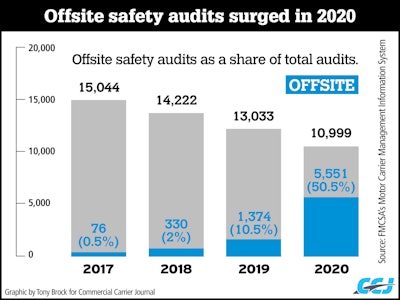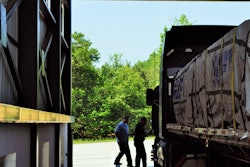 The total number of compliance reviews dipped last year from prior years -- a continued trend since 2017. However, the number of offsite audits jumped dramatically in 2020 from previous years.
The total number of compliance reviews dipped last year from prior years -- a continued trend since 2017. However, the number of offsite audits jumped dramatically in 2020 from previous years.
As with many other pandemic-driven aspects of the world that developed in 2020, the U.S. DOT and its state enforcement partners turned to remote options to conduct safety audits of trucking companies.
More than half of the 10,999 compliance reviews of carriers conducted last year were conducted as offsite reviews – via email and phone– rather than inspectors showing up in person to perform audits. Just 10% of audits were remote in 2019, and just 2% in 2018. In 2017, just .5% of all compliance reviews were held remotely, according to U.S. DOT data.
As reported by CCJ in August, the Federal Motor Carrier Safety Administration (FMCSA) and its state enforcers leveraged new authority last year as part of the federal government’s COVID-19 response, which allowed FMCSA to issue carriers’ safety ratings (Satisfactory, Conditional, Unsatisfactory) via remote audits, leading the surge in offsite reviews.
Lesley Sachs, a partner at the transportation-focused law firm Taylor & Associates, watched the spike occur last year and has been helping carriers navigate the review process. She says that, even if and when the pandemic subsides, the trend toward offsite compliance reviews is likely here to stay.
“FMCSA was putting this infrastructure in place and testing [offsite audits] even before the COVID pandemic,” she said. The need for physical distancing amid the pandemic “presented an ideal time,” she said, for the agency to turn to offsite reviews as a primary tool in its kit. “If the tool is working,” Sachs said, “they’ll continue to use it beyond COVID.”
Enforcers are still leveraging CSA scores to target motor carriers for safety audits, said Sachs. “It’s a good reminder for everyone that they need to be vigilant about paying attention to violations. And when you have them, put in corrective actions to stop it from becoming a trend, because those violations will draw attention if you’re selected for an audit.”
For example, Sachs said, a few instances of speeding violations by drivers should prompt a fleet to institute measures to mitigate violations rather than just paying the citations and moving on.
Likewise, carriers should put an emphasis on being organized in case they come under scrutiny by enforcers. “It’s a fast-moving process,” Sachs said. “They typically wrap up in a week to two weeks, and there’s not much wiggle room.”
Carriers should be ready to produce requested documents and files within 48 hours if they’re contacted for an offsite audit, she said. That will include company information and background files, and a sample of driver and vehicle files, accident records, hours of service records for drivers receiving citations or roadside violations, and drug and alcohol testing related to specific accident records.














